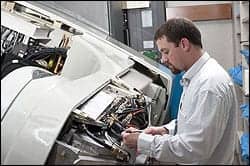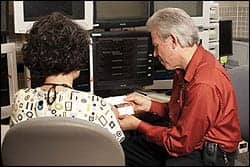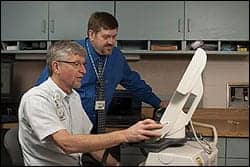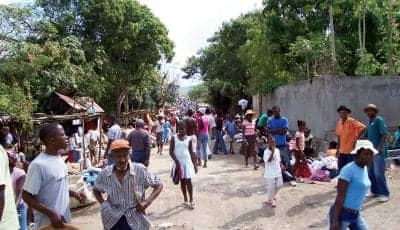
Radiation Therapy Service Specialist Brian Wallace takes test measurements on a linear accelerator.
One can still find screwdrivers and soldering guns in the biomed’s tool kit, but repairing modern medical equipment will more likely involve manipulating data on a computer screen. The subtle evolution has affected the workflow of clinical/biomedical engineers from coast to coast.
In Green Bay, Wis, Michael D. Engelke, divisional director, clinical engineering, St Vincent Hospital, could see the logic of reorganizing the department to work more seamlessly with IT and plant services. As a 36-year biomedical veteran, Engelke had meticulously learned countless new technologies and adjusted to seismic paradigm shifts. The reorganization would not be so difficult, but all change is uncomfortable—at least at first.
In 2008, Engelke characterized his group as essentially a loosely held division with no firm structure. The department performed well, but the parent health system—Hospital Sisters Health System (HSHS)—that governed St Vincent Hospital wanted to expand, divisionalize the business, and take over responsibilities at St Nicholas Hospital in Sheboygan and St Mary’s in Green Bay. To this end, administrators created new CEO and CFO positions for a new unified division.
In addition to these new executive posts, administrators hired a CIO and put together departments that made sense in light of new technological realities. “We were selected as part of the new division, which included IT, revenue cycle, and supply chain cycle,” Engelke says. “They took us out of plant services and put us under IT because that made sense. They took the three hospitals worth of IT people, plus the clerical system, and put us all together to make one big department.”
Management structure includes three directors in IT, one director for clinical engineering (Engelke), and another director for health information management—all added within the past year. Each director oversees three hospitals, plus the clinic system. “When we started there were 50 people in IT,” Engelke says, who graduated from the Army School of Medical Equipment Maintenance in 1975. “Now, as a large combined department, we are well over 200. It really got turned into something big.”
Compatibility and Accuracy

Darrell Elmer (R) discusses telemetry strips with a telemetry tech.
For departments looking to expand responsibilities to other sister facilities, much the way biomeds at St Vincent took over tasks at other nearby hospitals, Mike Donovan, CBET, has words of wisdom. First, know that database inventory software may not be accurate or compatible. Such was the case at sister hospital St Nicholas in Sheboygan, and it made for quite a headache.
Equipment information and assets had to be put into one equipment database, because the sister hospital, St Nicholas in Sheboygan, was using a completely different software package to document equipment, histories, and preventive maintenance (PM) schedules.
“We found that the old database we converted was very inaccurate, to the point that we had to go in on a weekend and do a complete sweep of St Nicholas Hospital,” Donovan says. “We had to write down the equipment that they had in their facility, then compare it to what we had in our database. That was a time-consuming project, but we wanted it all on one system, which happened to be TMS Enterprise from Four Rivers Software.”
After July 1, 2011, attention will shift to St Mary’s Hospital (Sheboygan), where inventory will again be a concern. St Mary’s is under contract with a third-party organization, but after the agreement ends in mid summer, Engelke’s group will manage the biomeds already on staff at the facility.
Respect Is Earned
Prior to the administrative transition to IT, the clinical/biomedical engineering department earned the respect of IT with its commitment to speed and efficiency. Medical monitors, in particular, enjoyed rocket maintenance times. “We’ve never really been adversaries of IT,” Engelke says. “Instead, we’ve tried to look for ways to cooperate, and even today we’re building application profiles of all the equipment that touches the clinical side of the house as well as the business systems.”
Decision trees help clear up any confusion, so no one utters the forbidden words, “It’s not my job.” On the contrary, if the help desk gets an inquiry, the initial authority to contact is clearly indicated, as well as the appropriate procedure to escalate the call. The same can be said for after-hours calls.
“We are really starting to work far more in tune,” Engelke says. “We’re having a dialogue about hybrid positions where IT would work right within clinical engineering, so we could have that internally instead of having to wait for someone to respond. These hybrid clinical engineering/IT positions are in the early stages, but it’s the wave of the future.”
Specifically, Engelke says an IT person could be assigned to clinical engineering and work in conjunction with a clinical engineering technician. The two people would interface as the primary contacts between medical equipment and the hospital backbone—acting as a user resource for any IT-related application problems.
Radiology specialists represent yet another hybrid, with PACS administrators likely providing direction for such new biomed positions. The possibilities are only limited by creativity. All told, about 80% of Engelke’s biomedical services are done in-house, with some radiology equipment still covered by the OEM.
Expanding the biomed umbrella to encompass additional hospitals brings critical issues of trust to the forefront. Darrell Elmer, biomedical technician at St Nicholas Hospital, confirms that gaining a measure of comfort was difficult at the beginning. “Even though we were, and are, affiliated with the same organization of sister hospitals, earning the trust of staff was tough at first,” Elmer says. “We walk in and say we are going to take over, and we are going to help you. We had to convince them that even though we work for St Vincent Hospital, we are here for you full-time at St Nicholas. One of the biggest things right off the bat was earning that trust.”
When Elmer helped take over biomedical services at St Nicholas, proving the worth of in-house work soon became the top priority. Elmer had encountered the same challenge when he took over the biomedical engineering department at Burlington Memorial Hospital, Burlington, Wis, where he would be on-site about twice a week.
“The ISO personnel might take an infusion pump, and the department would not get it back for 1 to 2 weeks,” Elmer says. “So, when I said, ‘I need to look at your infusion pump,’ they didn’t know when they were getting it back. I would have it back the next day or, most times, that same day. The scenario is similar to when we took over at St Nicholas.”
Once staff members become comfortable with the arrangement, the biomeds themselves want to know that they won’t become cogs in a huge machine. “Don’t forget about biomeds in the outlying hospitals of the organization when it comes to doling out test equipment, training, new tools, and allocation of funds,” Elmer cautions.
With all that said, Elmer acknowledges that there is still work to do within the three “Saints,” and it is getting better all the time. “We need to continue standardizing our medical equipment with the hospitals, because we have disparities in test equipment, parts usage, and training,” he says. “Once we standardize, it will be easier for staff to be trained. It will be easier to determine which test equipment, tools, and parts that we have to carry for the organization.”
Shedding the ISO

L-R: Mike Donovan, CBET, and Michael D. Engelke, divisional director, clinical engineering, discuss a test procedure on a ventilator.
Engelke’s biomed department started as a one-hospital service system, but now supports three hospitals plus additional clinics. HSHS ultimately decided to get rid of the independent service organization (ISO) that provided help for many years, a move largely made to increase the health system’s growing self-sufficiency.
The process was gradual, and new division leadership first brought in just one technician, adding another a year later. “It is not that the ISO was doing a bad job, it was just more efficient to have us all run out of one hospital,” Engelke explains. “It immediately brought a lot of credibility to the whole program, and it provided more consistency in how we did business.”
With potential help now spread over three facilities, Engelke could rely on 10 people if he needed them, whereas before he had only the small ISO. The third hospital (St Mary’s) is technically part of a different group, but this summer that contract will expire, and the group at St Mary’s will be fully integrated with the other two facilities.
Despite the city’s famous football team, Green Bay is not a major city like nearby Milwaukee or Chicago. As a result, a lot of ISO service people do not live locally, and that occasionally added up to long waits for clinicians. Nowadays, Engelke’s crew can at least take care of the first call to see whether more help is necessary.
Scott Richardson, a biomedical technician who works at the neonatal intensive care unit at St Vincent, says administrators have not hesitated to post for additional jobs when needed. “Fortunately, we have been able to hire additional staff to help with our bigger workload,” Richardson says. “The benefit we have with our new larger department under IT is that we are able to help another team member if he ever gets overwhelmed.”
Training Is a Priority
When the cancer center service line administrator came looking for speedier and more cost-effective ways to repair radiation therapy equipment, the move toward in-house help took another leap. Biomed Brian Wallace completed the training and readily stepped into the role of radiation therapy service specialist at St Vincent Hospital. Taking classes got Wallace off to a good start. In hindsight, the 5-year biomedical veteran believes it is better to get the learning done faster. “At first, we actually had a 3-year plan to take over service contracts,” Wallace says. “After going to a couple of schools, I asked Mike Engelke, ‘Can we bump it up and get it done as fast as possible?’ And we did. I ended up completing five service schools in a span of 13 months.”
Why cram so much information into a relatively short period of time? Wallace believes dealing with expanding duties is tough enough, but if a biomed has knowledge gaps due to unfinished training, it makes everything more difficult. “I could be up there fixing one problem and then they would run into another one with a different part of the machine, and I would have to say, ‘I haven’t been to that training,’ ” Wallace says. “When getting the approval to spend money on training, ask that the education be done as fast as possible. It was a hindrance not being able to know everything right away, so I asked to get it done faster. It is working out well. We are working on the linear accelerator, as well as a machine that allows clinicians to specifically administer radiation to the patient to avoid overexposing nontumor areas of the body.”
While it may sound touchy-feely, solid relationships depend on mutual respect, and these elements should not be neglected. “I hear all these stories about how IT and clinical engineering are warring or they don’t agree,” Engelke says. “It all boils down to a different philosophy of business. They are sometimes just as frightened of our side of the business as we are of theirs.”
Greg Thompson is a contributing writer for 24×7. For more information, contact .
A Unifying Trend
Right around the time Michael D. Engelke, divisional director, clinical engineering, St Vincent Hospital, Green Bay, Wis, and his staff were making the transition to IT, three major industry organizations began harnessing their collective wisdom to form the clinical engineering-IT (CE-IT) Community. Comprised of the Association for the Advancement of Medical Instrumentation, the American College of Clinical Engineering, and the Healthcare Information and Management Systems Society, the CE-IT Community set out to better understand the clinical engineering and IT issues and corral the best practices in one place.
As evidenced by the formation of the CE-IT organization, Engelke and his staff are not alone in their union with IT. While many departments still operate separately from IT, the convergence of the two departments does continue. “I would think the movement toward IT integration is a nationwide trend,” Engelke says. “And, if it’s not, it should be. There are a lot of reasons that it makes sense.” Engelke, who has seen it all, and his team have managed to thrive.
A white paper released late last year from CE-IT declared that among the hospitals surveyed, just one-third interface medical devices with electronic medical record (EMR) systems. “At most hospitals, the sole method of connectivity between EMRs and medical devices was through the use of a wired local area network (LAN) connection,” wrote the paper’s authors (full text available at www.ceitcollaboration.org). “While a number of organizations are using wireless connectivity in conjunction with wired LAN connectivity, only 8% of respondents reported that their hospital relies solely on wireless connections.”
The nuances of EMR/electronic health record (EHR) integration have taken on significance due to passage of the American Recovery and Reinvestment Act (ARRA) of 2009, signed into law in early 2009. As reported in the December 2010 issue of 24×7 and elsewhere, one of the key terms is Meaningful Use, which stems from the ARRA’s Health Information Technology for Economic and Clinical Health provision.
Conforming to newly released CMS guidelines that define Meaningful Use can qualify facilities for federal dollars. Incentives are expected to continue until 2021, so it figures that IT departments—increasingly with clinical engineering help—will endeavor to achieve Meaningful Use in the years to come.
Engelke and his team are in the midst of an Epic EMR installation, with the official go-live slated for October 1, 2011, at two hospitals, followed 90 days later by a third hospital.
“Epic spends a great deal of time going over the workflows to make them tailored to the facility,” Engelke says. “The EMR is built along with IT. They work hand in hand through the entire process. The only part we will be responsible for is the connection from the patient care equipment. One thing that makes my department unique is we built and maintain our own network for medical equipment. About 10 years ago we decided to create and manage our own network instead of using the hospital IT network; it seemed a cleaner way to do it. It still has a connection available to the hospital network as well. Now, working on installing the EMR, the HL7 interface will connect with our network and the hospital will pull data from the clinical engineering network.”
As long as biomeds and clinical engineers continue to strengthen their common bond and look for constructive ways to work with IT, Engelke is confident the nationwide trend will only accelerate, as will the drive to achieve so-called Meaningful Use.
“Meaningful Use is the primary driver for implementation of an EMR,” Engelke says. “We currently are switching from a system-grown record system, which is more than 20 years old. The CE-IT collaborative is leading the way for all of us to follow as they work to break down some of the barriers that still exist.”
—GT




